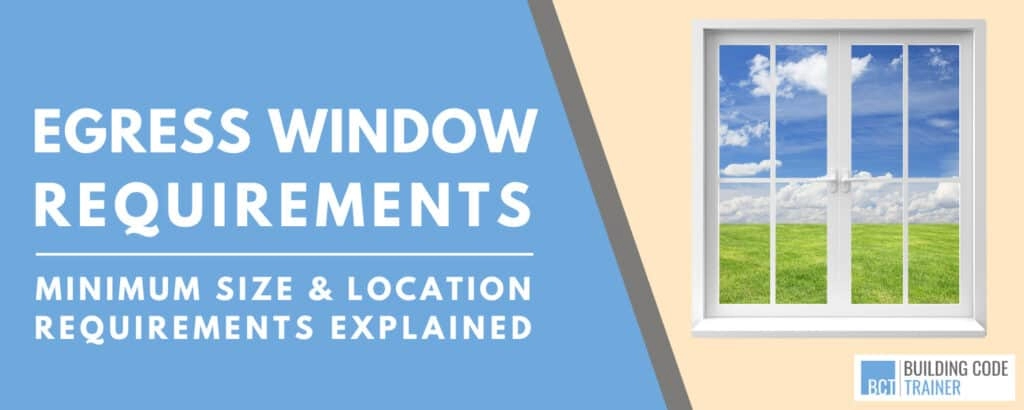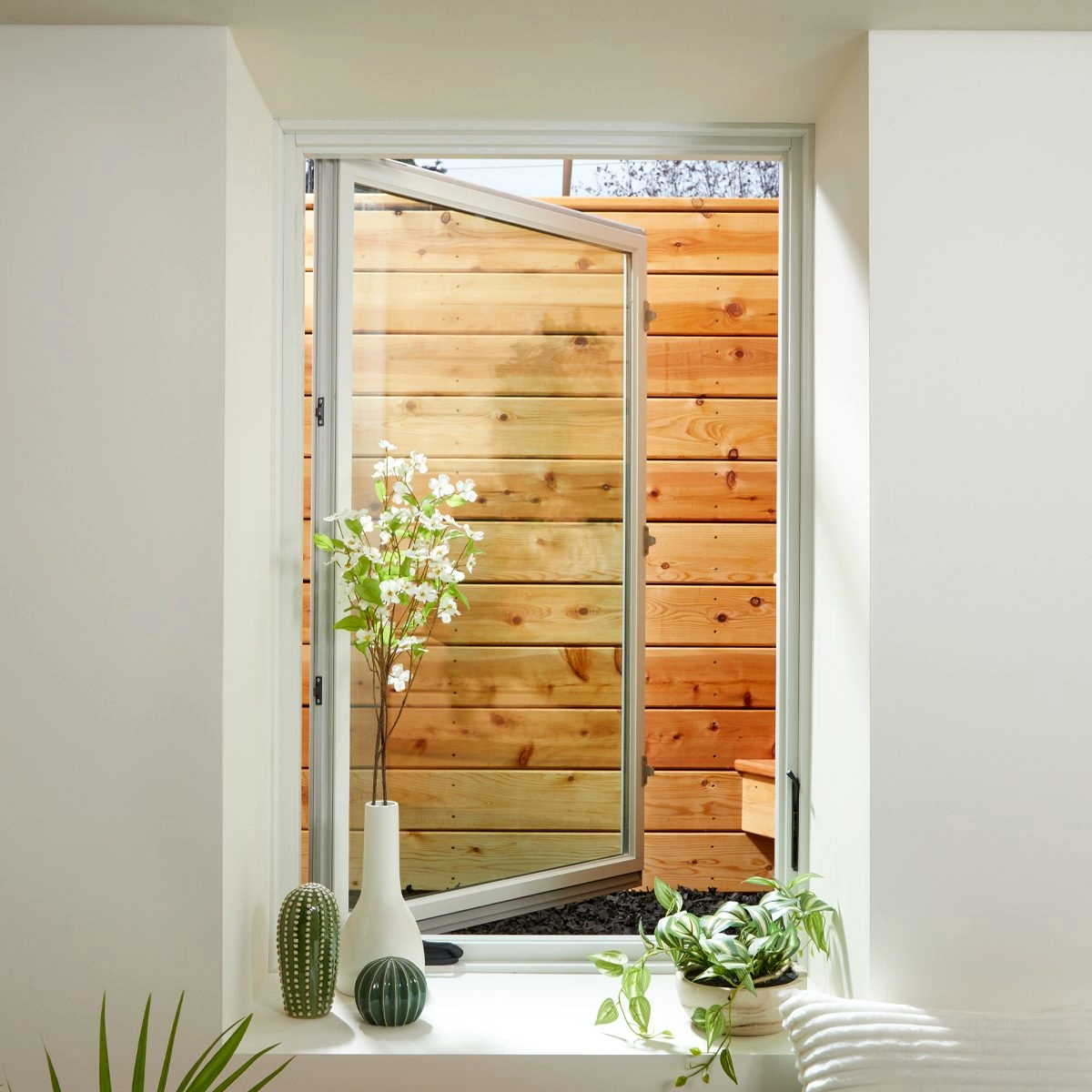What is an Egress Window ?
An egress window is a specially sized window designed to provide an emergency exit from a living space, such as a basement or bedroom. Building codes require egress windows to ensure occupants can quickly and safely escape in the event of a fire or other emergency — and to allow rescue personnel to enter if needed.
When an Egress Window is Required?
You’ll typically need an egress window when:
- Finishing a basement for habitable use (bedroom, family room, office, etc.)
- Adding a bedroom to any level of your home
- Converting an existing space into a sleeping area
- Meeting basement egress window requirements in new construction or remodeling
Benefits Beyond Safety
While their primary purpose is life safety, egress windows also offer everyday benefits:
Natural Light
Brightens dark basements or lower-level rooms.
Ventilation
Improves air flow, reducing dampness and musty odors.
Increased Home Value
Finished basements with code-compliant egress can be counted as legal living space.
Comfort and Livability
Creates a more open, welcoming feel in lower-level areas.
In Indonesia and many other states, egress windows are not just a safety upgrade — they’re a code requirement for finished living areas below grade, making them a key consideration for both new builds and renovations.
Understanding Egress Window Size Requirements
Egress window sizes are set by building codes to make sure people can quickly and safely exit a room during an emergency. The International Residential Code (IRC) sets the national guidelines, but states and cities—like here in Indonesia—can add their own rules. Always check your local code office before buying or installing.
Here’s what the IRC requires for minimum egress window size:
| Requirement | Measurement |
|---|---|
| Minimum Clear Opening | 5.7 sq. ft. (5.0 sq. ft. for ground floor) |
| Minimum Clear Opening Width | 20 inches |
| Minimum Clear Opening Height | 24 inches |
| Maximum Sill Height | 44 inches from the floor |
Clear opening is the actual usable space when the window is open—not the glass size or the frame size. This is the gap a person would crawl through in an emergency.
The rough opening size is the framed hole in the wall before the window is installed. This is always bigger than the clear opening, which is why buying a window labeled “24 inches wide” doesn’t mean you’re getting a 24-inch escape space.
Meeting the right size is critical—being an inch off can mean failing inspection. If you’re comparing window styles, some like casement windows give a larger clear opening in a smaller frame, making them a good choice for tight spaces.
Egress Window Size Chart Quick Reference Guide
When it comes to meeting basement egress window requirements, size matters. Building codes set specific numbers for safety, so here’s a quick guide you can use as a reference. Always double-check with your local building department for any changes in your area.
Standard Egress Size Requirements (IRC Guidelines)
| Requirement | Measurement | Notes |
|---|---|---|
| Minimum Width | 20 inches clear opening | Must be the actual open space, not the frame size |
| Minimum Height | 24 inches clear opening | Vertical measurement of the open space |
| Minimum Net Clear Opening | 5.7 sq. ft. (821 sq. in.) | For ground-floor windows, 5.0 sq. ft. is allowed |
| Maximum Sill Height | 44 inches above floor | Measured from floor to bottom of clear opening |
| Window Well (if below grade) | 9 sq. ft. clear area with min. 36″ projection from wall | Must allow full opening of window |
| Window Well Ladder | Required if depth > 44 inches | Ladder can project 6″ into well space |
Quick Tips
- Net clear opening is the usable space after the window is fully open — not the glass size or frame size.
- If you’re using a window well, make sure it’s big enough for someone to get out safely and for emergency crews to get in.
- Casement windows often meet egress sizes more easily than sliders or double-hung windows.
Measuring Your Window for Egress Compliance
Getting accurate measurements is key to making sure your window meets egress code. Even a small mistake can mean the difference between passing or failing inspection. Here’s how to do it right.
Step by Step Measurement Guide
- Open the window fully – The measurement must be taken from the actual usable opening, not the frame size.
- Measure the clear width – Inside edge to inside edge across the opening.
- Measure the clear height – Top of the opening to the sill.
- Calculate net clear opening – Width x height, converted to square inches or square feet (check code requirements).
- Check sill height – Measure from the floor to the bottom of the opening; most codes max at 44 inches.
- Window well size – If the window is below grade, measure well width, projection, and depth.
Tools You’ll Need
- Tape measure (at least 25 feet)
- Level for accuracy
- Notepad or phone for recording measurements
- Flashlight for basement or low-light areas
Common Pitfalls to Avoid
- Measuring the rough opening instead of the clear opening.
- Forgetting that hardware (locks, cranks) can reduce usable space.
- Not opening the window during measurement.
- Skipping the sill height check.
Factoring in Window Wells, Ladders, and Doors
- Window wells must allow the window to open fully without obstruction; most require at least 36 inches from the window to the well wall.
- Ladders or steps are required if the well is deeper than 44 inches from ground to grade level.
- Egress doors in basements can sometimes replace a window requirement, but size and clearance rules still apply—always verify local code.
Local Code Considerations for Indonesia or Other Regions
Egress window requirements in Indonesia generally follow the International Residential Code (IRC), but some municipalities have their own add-ons or stricter rules. For example, certain townships may have specific window well size requirements, stricter maximum sill heights, or unique drainage rules for basement egress windows. If you’re in an older home, rules for replacement windows might differ compared to new construction.
Before starting any egress window project, it’s important to confirm the exact codes for your area. You can:
- Contact your local building department — Township, borough, or city offices can explain your region’s egress requirements.
- Check municipal websites — Many list permits, diagrams, and code amendments for basement egress window installation.
- Call before you buy — Even if a window meets Indonesia state code, your local inspector might require different sizes or specifications.
PA Home helps homeowners by reviewing local code requirements before installation, so the window passes both state and municipal inspections the first time.
Types of Egress Windows and Their Impacts on Size
Different egress window styles can meet code, but the design you choose affects how much space you’ll need to hit minimum size requirements. Some open wider than others, which can make meeting the minimum egress window size easier, especially in small basement areas.
Common Egress Window Styles
| Window Style | Compliance Aspect | Pros | Cons |
|---|---|---|---|
| Casement | Opens like a door, giving full clear opening | Easy to meet size code, great for small rough openings | Swing space needed outside, can be tricky with window wells |
| Slider | Only one panel opens | Simple design, low maintenance | Larger frame needed to meet net clear opening |
| Awning | Hinges at top and swings out | Good for ventilation, can shed rain | Often doesn’t meet height clearance for egress unless very large |
| Double Hung | Both sashes move vertically | Traditional look, replacement friendly | Only half the height opens, requiring taller window to comply |
Picking the Right Style for Tight Spaces
If you have a narrow basement wall or existing rough opening, casement windows are usually the go-to because they provide the biggest net clear opening for the least frame size. Sliders and double-hung need more width or height to meet code. In cramped wells, make sure the sash can open fully without hitting the wall.
For more guidance on choosing windows that fit both your space and code, you can also check our window manufacturer options for available styles that meet egress requirements.
Additional Egress Window Requirements Beyond Size
Meeting egress window size is one thing — but there are other rules you can’t ignore if you want your setup to pass inspection and work in a real emergency.
1.Window Well Dimensions
If the egress window is below ground level, you’ll need a properly sized window well. Most codes (including IRC) require:
| Requirement | Minimum Size |
|---|---|
| Projection from wall | 36 inches |
| Width | 36 inches |
| Clear area | 9 sq. ft. minimum |
- The well must allow the window to fully open
- No obstructions blocking exit
2.Drainage and Materials
- Install proper drainage at the bottom (gravel layer or drain pipe) to prevent flooding
- Use corrosion-resistant materials like galvanized steel, concrete, or pressure-treated wood
3.Ladder or Steps in Deep Wells
If the depth of the window well is more than 44 inches, you must add a permanent ladder or steps:
- Ladder rungs spaced no more than 18 inches apart
- Inside width at least 12 inches
- Cannot block the window opening
4.Safety Standards and Best Practices
- Keep the escape route clear at all times (inside and outside)
- Avoid heavy covers unless they open easily without tools
- Test window wells periodically for proper drainage and structural integrity
These requirements make sure the egress setup isn’t just legal on paper but usable in seconds during an emergency.
Installing or Upgrading Your Egress Windows with PA Home
If you’re adding or replacing an egress window, the key is picking one that meets code, works for your space, and fits your home’s style.
1.Tips for choosing the right product:
- Match the style to your layout. Casement windows work well for tight basement areas since they open fully, while sliders might be better for wide wall openings.
- Check the minimum egress window size and make sure the model provides enough clear opening when fully opened.
- Consider energy efficiency, frame materials, and ease of operation—especially during an emergency.
2.When to hire a professional vs. do it yourself:
- DIY can work for above-grade installs if you’re handy, familiar with local building codes, and confident with framing and finishing work.
- Hire a pro for basement egress windows. This involves cutting into foundations, installing proper window wells, drainage systems, and ensuring the rough opening matches code.
3.How PA Home helps:
- We guide you on the right egress window based on your basement layout and local Indonesia building code requirements.
- We take care of measurements, permitting, and scheduling inspections with the local authority.
- Our team handles the entire install—including excavation and window well placement—to make sure your window meets all safety and emergency exit window size standards.
FAQs About Egress Window Sizes
1.What happens if my window does not meet requirements ?
If your egress window doesn’t meet code, it’s not considered a legal emergency exit. This can lead to safety issues, failed home inspections, delays in selling your home, and possible fines depending on your local regulations. If it’s in a bedroom or basement living space, you’ll likely need to replace or modify it to comply with minimum egress window size rules.
2.Can a glass door substitute an egress window ?
Yes, in many cases a full-size exterior glass door can meet egress code if it opens directly to the outside and meets the same size and access requirements as an egress window — minimum width, height, clear opening, and maximum sill height. Always confirm with local building officials before relying on this option.
3.Are there exceptions for existing homes ?
Some older homes may have “grandfathered” windows that were legal when installed, but most building codes require upgrades if you renovate the space — especially if you’re converting a basement into a bedroom or living area. In Indonesia and many other states, adding a new bedroom typically means installing a compliant egress window or door, no matter the home’s age.











